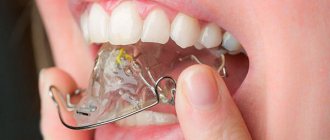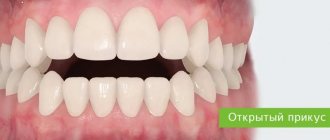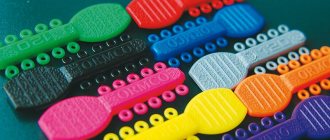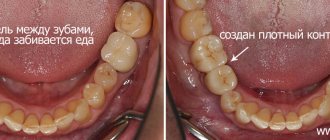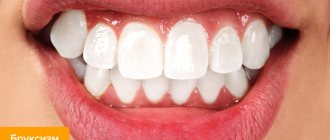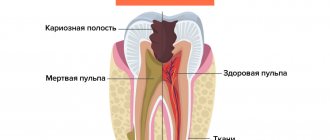Home / Articles / Impacted fang
It has long been known that teeth can fall out too early and humanity is trying to combat this problem in every possible way. Recently, another problem of a slightly different nature has appeared - teeth began to erupt ahead of time, and this leads to another problem - an impacted tooth. Most often, this happens in childhood, while adults are faced with impacted teeth at the time of the eruption of the so-called “wisdom teeth” or eights. What is an impacted molar or canine tooth, why does it need close monitoring, and should it be removed?
Causes of impacted teeth
- Due to injury or damage to the jaw;
- If the child’s primary fangs were pulled out prematurely;
- Incorrect location of the tooth germ;
- Dental crowding, which means teeth are too close together;
- Inflammatory diseases of baby teeth and gums;
- The presence of “extra” teeth (supercomplete);
- Poor nutrition;
- Rickets;
- Exhaustion or weakness of the body.
The main prerequisite for the appearance of retention is the peculiarities of the child’s development in the embryonic period (lack of minerals in the body, thickening of the mucous membranes, low fetal growth rate).
Materials and research methods
To accomplish the assigned tasks, 26 patients aged from 12 to 45 years old with a diagnosis of canine retention in the upper jaw were examined and treated. Of these, 10 patients (38%) were diagnosed with vestibular retention of the canines, and 16 patients (62%) were diagnosed with palatal retention of the canines.
In patients with vestibular retention of the canine in the upper jaw (10 people), a delay in the change of primary canines was observed in 6 patients (60%), edentulous lateral incisors in 2 patients (20%). Bilateral vestibular retention was detected in 2 patients (20%).
In patients with palatal retention of the canines on the upper jaw (16 people), a delay in the change of primary canines was observed in 12 (75%), edentulous lateral incisors in 4 (25%).
The presence of supernumerary tooth rudiments in the area of the impacted canine was noted in one patient. Bilateral palatal retention of the canines was detected in 2 patients.
Patients diagnosed with palatal impaction of the maxillary canine teeth were further divided into two separate groups, as the location of the canine can vary greatly and the treatment strategy depends on its location. The crown of the canines in patients of the 1st group was located no higher than the level of half the length of the incisor root, the crown of the canines of the 2nd group of patients was located above the level of half the length of the incisor root.
42 orthopantomagrams were analyzed, 10 targeted intraoral radiographs and 4 occlusal radiographs were taken.
Surgical exposure of 28 crowns of impacted canines was performed, of which 10 were vestibular impacted, 16 were palatally impacted.
Orthodontic traction was initiated by 28 impacted canines in the maxilla. During orthodontic treatment, 28 impacted canines were installed in the dentition, the position of the teeth and the shape of the dentition were normalized. Associated malocclusions accounted for 91% of the total. In 2 patients over the age of 30 years, impacted canine teeth were diagnosed with impacted canine ankylosis at the stage of orthodontic traction. The diagnosis was established on the basis of the absence of canine movement during 6 months of active orthodontic extrusion, the occurrence of deformation of the occlusal plane, and displacement of adjacent teeth. Ankylosed canines were removed, orthodontic treatment of associated occlusion anomalies was performed, and a space was prepared for prosthetic replacement of the missing canine using the implantation method.
The models determined:
- size, shape, position of individual teeth;
- the shape and size of the dentition in three mutually perpendicular planes;
- type of closure of the dentition;
- presence of diastemas, three;
- shape of the lateral incisor;
- the presence of a delay in the change of primary canines.
When studying diagnostic models of jaws, the methods of Pon and Corkhouse were applied.
In patients diagnosed with vestibular retention of canines in the upper jaw, narrowing of the upper dentition in the area of premolars and molars was found in 8 people (53% of cases), expansion - in 7 patients (46% of cases). Shortening of the anterior portion of the dental arch occurred in 12 patients (80%).
In 7 patients with palatal retention of the maxillary canines, shortening of the anterior portion of the dental arch was observed in 92% of cases. Expansion of the dentition in the area of premolars and molars was observed in 19 patients (62%), narrowing in 9 patients (29%).
The data obtained confirm the theory of the occurrence of canine retention in the upper jaw, according to which one of the reasons for the occurrence of vestibular retention of canines is the narrowing of the dentition, and palatal retention is their expansion.
Thus, orthodontic treatment of maxillary canine retention can be carried out at any age in the absence of contraindications and after a detailed diagnostic examination.
The strategy for orthodontic treatment of canine impaction in the upper jaw depends on the location of the impacted canine, its location relative to adjacent teeth, and the condition of the tissues surrounding the impacted canine.
Indications for orthodontic treatment of patients with impacted canines in the upper jaw are displacement in the mesiodistal direction relative to the upper dentition on the vestibular or palatal side, in the absence of resorption of the roots of adjacent teeth and when the angle of inclination of the impacted canine to the midline is no more than 500.
Types of location of an impacted tooth
| Fine | The tooth has a vertical position and grows upward very slowly. Baby teeth and canines can grow properly. “Wisdom teeth” are rarely positioned normally. |
| Horizontally | The impacted tooth forms a right angle to the healthy one, located horizontally. This situation is detrimental to a healthy “neighbor”. In such a situation, it is necessary to remove the impacted tooth, which is performed only surgically. |
| Obliquely | An impacted tooth grows at an angle toward the cheek or tongue. If such an anomaly does not cause inconvenience to a person, then removal is not necessary. |
Removal of lower canines
A significant difference between the fangs is the presence of a particularly massive long root. In many cases, such a root has a slight curvature in its upper part. There are often cases when the root of the fangs has additional branches. After administering anesthesia to the patient, the doctor begins the tooth extraction procedure. Here, preference is given to tongs with wide cheeks. This tool provides a high-quality, reliable grip. The tooth is dislocated by swinging outward toward the cheek, followed by swinging inward toward the tongue.
Symptoms of tooth impaction
In most cases, an impacted tooth is detected on an x-ray at the dentist or at an appointment with an ENT doctor. Retention in a child can be determined if one of the elements of the jaw row is absent for a long time or if a baby tooth is not replaced by a permanent “brother” for too long. The eruption of an impacted tooth is usually accompanied by inflammatory processes. The child may be bothered by swelling of the gum tissue and jaw, pain and aches, numbness and tingling in the retention zone.
On palpation of the gums, thickening and hardening are noted, reminiscent in shape and outline of an unerupted tooth.
How is upper jaw teeth removed?
Before the operation, an examination is carried out, if necessary, radiography, consultations with other specialists. Typically, tooth extraction surgery is performed on an outpatient basis. Local anesthesia is most often used. Before the operation, the mucous membrane and teeth are cleaned to prevent infection of the socket. For tooth extraction, forceps and elevators are used, and in some cases, the tooth root is cut out with a bur. Special forceps are used to remove the wisdom tooth of the upper jaw.
Removing the upper front teeth is usually simple. Certain difficulties arise when removing the upper canine, since it has a long, massive root, the apex of which is very often curved, as well as when removing molars, since they have three roots.
When removing the upper teeth, the patient sits in a chair with a slightly reclined back and headrest. The dentist is positioned to the right and in front of the patient.
Stages of tooth extraction:
- Separation of the gums from the edge of the alveolus and the circular ligament from the neck of the tooth (with a raspatory or a trowel);
- Applying and advancing forceps under the gums, fixing them;
- Rocking or rotation of the tooth, during which the periodontal fibers that connect the tooth root to the walls of the socket are torn;
- Extracting a tooth from the socket;
- Inspection of the surgical site, extraction of small pieces of bone and tooth roots.
The success of the operation does not depend on the physical strength of the dentist, but on the correct execution of all stages of the procedure. Minor bleeding from the hole stops after 2-5 minutes, the hole is filled with a blood clot, which protects the wound from infection. To avoid damaging the clot and causing bleeding, the patient is advised not to rinse the mouth or eat food for several hours. On the day of surgery, you should not consume hot food or drinks, or take any thermal procedures; it is recommended to refrain from heavy physical activity. If all recommendations are followed, the tooth healing process will proceed quickly.
Removal of impacted teeth
If there are no complaints at all about the impacted tooth, and it does not cause any inconvenience (cysts do not form near it, the mucous membranes of the mouth are not injured), then removal may not be necessary. But if the impacted tooth is not removed, then it is necessary to undergo an X-ray examination of the mouth 2 times a year.
However, there are a number of cases when it is necessary to remove an impacted tooth:
- Retention causes constant inflammatory processes in the oral cavity;
- The occurrence of various paradental or follicular carpal formations, abscess, osteomyelitis in the gum tissue;
- Injuries and scratches of the oral mucosa that are caused by retention;
- An impacted molar or canine is also dystopic (improperly positioned in the dental arch) towards the cheeks or tongue.
The main factors on which the decision is made to remove impacted teeth are:
- The likelihood of injury during surgery,
- The location of the canine or molar and ease of access to them,
- Possibility of complications.
In most cases, the operation is painless and eliminates the possibility of pain even after the anesthesia wears off.
The removal of an impacted tooth itself takes place in several stages:
- pain relief by local anesthesia,
— an incision in the gum above the impacted canine and removal of a flap of tissue of the mucous membrane and periosteum,
- sawing out the bone to the dental crown using a drill,
- removal of a fang or molar from the bone using forceps (special biomaterials are left in its place).
Removal of premolars located on the upper jaw, canines and molars of the lower jaw has its own characteristics:
- Due to the fact that the roots of the teeth of the upper jaw are sometimes located close to the sinus, their removal must be carried out with the utmost care.
- In the case where the maxillary sinus has nevertheless been opened, medical treatment of the hole is not carried out, and the place where the bone has been broken is immediately sutured.
- Then a biomaterial is placed inside, which will promote rapid and painless overgrowth of bone tissue.
- The previously removed flap of mucous tissue and periosteum is returned to its place and sutures are applied.
- When removing impacted teeth in the lower jaw, the dentist must determine their location as accurately as possible, calculating their proximity to the mandibular canal. The safest way to access such teeth is through the vestibule of the mouth.
Possible complications
After removing the fang from the socket, various complications may develop, which in the vast majority develop due to infection of the wound.
Dry socket syndrome
The problem arises due to the patient’s failure to comply with the doctor’s recommendations or too active treatment of the oral cavity with antiseptic solutions. The actions lead to the fact that a blood clot does not have time to form in the wound, protecting the soft tissues from the penetration of pathogenic microorganisms.
The condition is not life-threatening, but can cause a number of consequences, for example, inflammation of a postoperative wound.
Alveolitis
The disease is an inflammatory process that spreads to the mucous membranes of the socket. Alveolitis causes infection to spread to bone structures. Pathology rarely develops after the removal of fangs on the upper jaw; more often, this condition appears after the extraction of molars located in the lower row.
Nerve injury
If the canine is positioned incorrectly or has a curved root, then during surgery damage to its nerve endings may occur. Characteristic symptoms of this condition are loss of sensitivity in the operated area, numbness of the cheek, and the appearance of “running goosebumps.”
Alveolar exposure
Even with a normal course of the postoperative period, problems with wound regeneration may occur. If pain occurs at the site of the hole when consuming hot or cold food, this indicates that the area of the bone is not covered with soft tissue.
Cyst on a tooth
The development of a pathological formation after canine removal is a rare consequence. A cyst is a growth filled with fluid. In this way, the human body independently separates infected soft tissue from healthy areas.
The tumor, increasing in size, can spread to neighboring areas and therefore requires immediate surgical intervention.
The occurrence of odontogenic phlegmon
The pathology develops against the background of osteomyelitis of the jaw structures. The problem manifests itself as pain and swelling of the cheek in the upper jaw area. It becomes difficult for a person to open his mouth and consume food. The pathology is accompanied by a deterioration in health and a rise in temperature.
Odontogenic periostitis
It develops against the background of alveolitis or osteomyelitis and is an inflammation of the periosteum. The condition is manifested by a number of the following symptoms:
- rise in temperature;
- toothache ;
- swelling on one side of the cheek.
Removal of the maxillary canine is carried out taking into account the structure of this element of bone tissue. The tooth has only one root, which in 30% is located in the wrong position. The stages of surgery for this type of intervention are no different from removing the remaining elements located in the top row. Depending on the location of the canine and the condition of its crown, the doctor performs simple, complex or atypical tooth extraction.
Why does a canine or molar not appear?
The concept of retention refers to the anatomical specificity of the jaw or an anomaly in the formation of the tooth germ. Experts believe that this pathology arose in modern society as a result of eating too soft food, i.e. people have practically stopped chewing solid food. Other reasons why retention may occur:
- improper feeding of the child;
- reduced immunity associated with exposure to infections;
- delay in replacing milk teeth with molars;
- the presence of supernumerary teeth that prevent the eruption of a permanent tooth;
- incorrect location of the permanent tooth germ in the jaw bone. With this pathology, the crown of the tooth is directed towards the root of the adjacent tooth, thereby preventing its appearance and the eruption of neighboring teeth;
- bad heredity.
